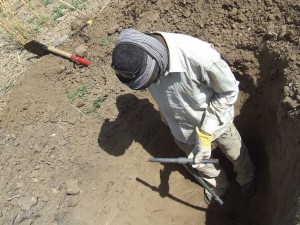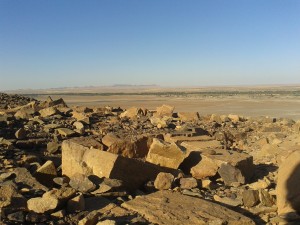It is somewhat unusual when you are just 150cms tall, a female with a different skin colour, wearing uncommon attire, do not speak the language and are moving around alone in the desert with a knife and a hammer. Infrequent passersby in their cars or on their donkeys stop by and ask you whether you are lost or not! Well, that exactly what had happened when I, a geoarchaeologist, had been working in and around the New Kingdom temple Town of Sai Island. I joined the AcrossBorders team during the field season of 2015 and what an interesting season it had been!
I undertook geoarchaeological survey in the vicinity of the site. I was mostly assisted in the field by Hassan Dawd, a local from the island and since many years one of the best workmen assisting in the field. Not only did he take a keen interest in digging holes as per my instructions, but was of utmost help in keeping the dreadful date flies (called nimiti in Sudan) away by burning donkey dung, so as to allow me to concentrate in my job. Well, in that respect I can point out that the donkeys have also been very supportive. I was also occasionally assisted in the field by various other team members namely Miranda Semple and Martin Fera.
During the 2015 field season at Sai, I was assigned with objectives of placing the archaeological site in its environmental context, to understand the nature of any surface preparation prior to the establishment of the settlement, provenance of sandstones found within the Pharaonic town, potential sandstone quarry locations and to shed light on any possible harbour/landing ground on the island during the period concerned. To try to have some answers for these objectives I conducted test pitting, hand auger profiles (I somehow tend to relate this Dutch auger with a magic-wand; not only there is a visual similarity but also this can create absolute magical interpretation out soil profiles) and of course looked out for exposed and available sections and quarry pits. At each profile loci, the stratigraphy was located, recorded and photographed and old land surfaces sampled as appropriate. Three types of samples were taken: intact soil block samples for micromorphological analysis, small bulk samples for physical characterisation (pH, particle size analysis, organic content using loss-on-ignition, multi-element analysis) and sand-stone blocks for petrographic analysis.
Six profiles were recorded from the landscape survey and seven sets of soil block and bulk samples were collected. In addition, from Profile 9 in SAV1 N, two sets if soil block and bulk samples were collected from below the contact zone of the anthropogenic sediments and natural soil. Besides these, thirty-nine rock samples have been collected for further scientific analysis from different sandstone outcrops of the island and from on-site debris. These outcrops are mainly at Jebel Adou and the village of Adou, where at least 4-5 quarry places (unsure of the period of quarrying though) have been marked. The aim behind collecting sandstones from on-site debris was to provenance their sources by characterising their mechanical and chemical properties.
Now I very much look forward to process all these samples and to have a rich pool of data. My sincere thanks to Julia all the other team members for making work so easy. We will keep you updated about our geoarchaeological findings.


